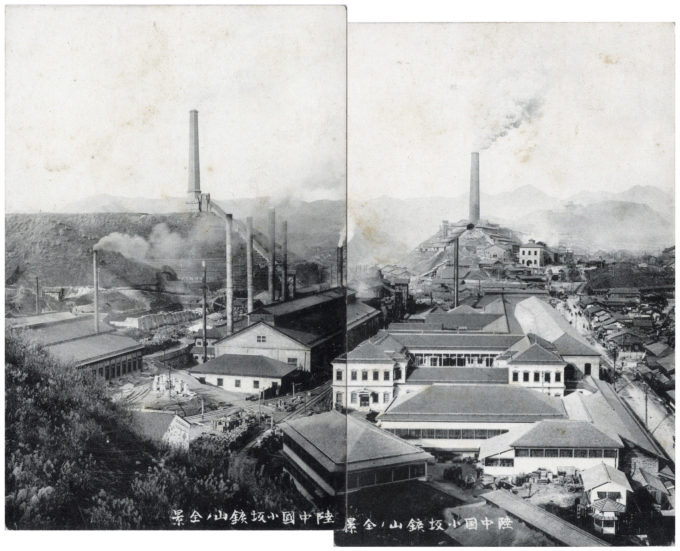
Kosaka Copper Mine, Kosaka, Akita Prefecture, panoramic duo-postcard, c. 1920, became one of the most productive copper mines in Japan after its opening in 1816 during the late Tokugawa period. Its deposit of kuroko [black ore] was the largest of its kind in the country.
See also:
Yawata Iron and Steel Company, Yawata, Kyushu, c. 1940.
Chemistry Laboratory, c. 1940.
“The Kosaka mine was one of the largest copper, lead and zinc mines in Japan, and one of the highest producing mines in all of Asia. The mine is located in Tōhoku region of northern Japan in the town of Kosaka, Akita Prefecture. During the early 1900’s, until the silver lode played out, Kosaka was also the highest producer of silver in Japan (over 177 million ounces).
“In 1816, development of gold and silver deposits began under the Nambu clan of Morioka Domain, with the mine under the control of the Fujita-gumi mining guild. After the Meiji restoration, in 1871, the mine was nationalized, and in 1873 [a] foreign advisor, German metallurgist Curt Adolph Netto, was recruited by the Japanese government and placed in charge of modernizing the mine. In 1884 the mine was privatized and sold to the Fujita-gumi, which later became Dowa Holdings, one of the largest non-ferrous metals producers in Japan.
“Following 1901, improvements in smelting technology enabled the company to exploit its large deposits of ‘black ore’ (a mixture of copper, zinc and lead). By 1907, it was the largest producer of copper in Japan.
“Due to Kosaka’s importance and its thriving industry, the residents of the area were some of the first of Japan to enjoy the benefits of electricity, plumbing, and running water. In order to attract workers to the remote location, the company built much of the local infrastructure, including apartments, a hospital, a kabuki theater and a movie theater, as well as a railroad to connect the town with the Ou Main Line railway at Ōdate. But with the end of World War II, the raw ore needs of the Japanese waned. Kosaka’s population would drop by over 60% (est. 20,000 people in 1940 to est. 7,000 by the year 2000).
“Though the mines would continue to produce ore until almost the end of the 20th century, by the end of the 1970’s Kosaka’s place in Japan and Asia had been superseded. Kosaka’s last mine ceased operations in 1990, and has since been converted into a recycling and future-tech plant.
“The Meiji period Kosaka Mine Headquarters and Kosaka’s Korakukan Kabuki Theatre (opened in 1910) were each designated an Important Cultural Property in 2002. The mine itself is no longer an active mine.”
– Wikipedia

